Performance of zero-till wheat (Triticum aestivum L.) and weed species as influenced by residue and weed management techniques in rice based cropping system
Bạn đang xem bản rút gọn của tài liệu. Xem và tải ngay bản đầy đủ của tài liệu tại đây (384.53 KB, 8 trang )
Int.J.Curr.Microbiol.App.Sci (2019) 8(4): 270-277
International Journal of Current Microbiology and Applied Sciences
ISSN: 2319-7706 Volume 8 Number 04 (2019)
Journal homepage:
Original Research Article
/>
Performance of Zero-till Wheat (Triticum aestivum L.) and
Weed Species as Influenced by Residue and
Weed Management Techniques in Rice based Cropping System
Rakesh Kumar1*, U.P. Singh2 and Gaurav Mahajan3
1
Department of Agronomy & Soil Science, CSIR-CIMAP Research Centre,
Pantnagar-263149, India
2
Department of Agronomy, Banaras Hindu University, Varanasi-221005, India
3
Department of Agronomy, College of Agriculture, Rewa-486114 (JNKVV), India
*Corresponding author
ABSTRACT
Keywords
Residue
management, Weed
control, Zero
tillage, Wheat
Article Info
Accepted:
04 March 2019
Available Online:
10 April 2019
A field experiment was conducted during 2005-06 to 2006-07 at Varanasi to find out the
effect of three residue management practices viz. R1 (Residue Removal), R2 (Residue
Retention alone), R3 (Residue Retention with Trichoderma) and four weed management
treatments viz. W1 (Control), W2 (Hand weeding at 30 &45 DAS), W3 (Isoproturon +2,4-D
(1.0+0.5 ha-1 at 30 DAS), W4 (Fenoxaprop 120 g a.i. ha-1 fb Metsulfuron 4g a.i. ha-1 ) on
weeds and productivity of zero-till wheat (Triticum aestivum L. emend Fiori & Poal) in
rice-wheat cropping system during the winter (rabi) season. Wheat grown under rice wheat
cropping system with residue retention with Trichoderma application produced 8.2 and 6.8
% higher grain and 7.3 and 6.2 % straw yield over residue removal treatment during both
the year of experimentations. Out of all residue management approaches under test,
residue management alone along with isoproturon + 2, 4-D application for weed control
gave higher net returns during the course of above study.
stemmed from the exhaustive nature of both
the crops because belonging to the same
family and their extreme tillage requirement.
The
new
Resource
Conservation
Technologies (RCTs) develop over the past
ten years provide an opportunity to reduce the
cost of production. Among these, new RCTs,
the zero tillage technologies of wheat
cultivation have been adopted over large
areas. This technology save more than 90%
energy, time, labour and helps to produce
wheat at a much lower cost. Uncontrolled
Introduction
Rice (Oryza sativa L.) - Wheat (Triticum
aestivum L. emend Fiori & Poal) cropping
sequence is the most predominant production
system occupying about 18 Mha in Asia, of
which 13.5 Mha area in Indo-Gangetic Plains
(IGP) of India (10 Mha), Pakistan (2.2 Mha),
Bangladesh (0.8 Mha) and Nepal (0.5 Mha)
and feeds about 1.3 billion people (20% of the
world population) (Farooq et al., 2007,
Saharawat et al., 2010). This grin scenario is
270
Int.J.Curr.Microbiol.App.Sci (2019) 8(4): 270-277
(Fenoxaprop 120 g ha-1 fb Metsulfuron 4 g
ha-1). During both the years’ wheat crop was
sown with zero tillage maintaining the rice
residue in respective plots as per treatments
allocated. Isoproturon + 2, 4-D (1.0+0.5 kg
ha-1) at 30 DAS) and Fenoxaprop (120 g ha-1)
fb Metsulfuron (4 g ha-1) were applied as post
emergence with 500 liters of water with the
help of knap sack sprayer, fitted with flat-fan
nozzle at 30 DAS. Rice ‘Sarjoo-52’ was
grown from June to October for residue
purpose only as a commercial crop and no
observations were made and wheat ‘HUW234’ was grown from November to March in
each treatment with recommended package of
practices. The experiment was conducted
under irrigated conditions. Weed density was
recorded (at 45 and at harvest stage) from
0.25 m-2 area by placing a quadrate of 0.5 ×
0.5 m randomly at three places in each plot. A
total ten species of weeds enclosed in each
quadrate were identified as well as counted
species wise and was expressed as number of
weeds per square meters.
weed growth may reduce wheat yield ranging
from 15-40 % depending upon magnitude,
nature and duration of weed infestation (Jat et
al., 2003). These call for the use of other
broad
spectrum
herbicides
either
independently or in combination for the
management of complex weed flora of wheat
to avoid perceptible change in weed flora.
The weeds were reduced under zero till
sowing in standing stables as rice straw acted
as mulch, in partial burning treatment due loss
of viability of weed seeds due to high
temperature generated during burning and in
bed planting due to drying of bed tops which
reduced the germination of weeds and hence
dry weight was also less under these treatment
(Brar and Walia, 2007). Less effort has been
made to manage weed population by
imposing diverse designed tillage techniques
with residue retention. Hence, the present
study was, therefore, undertaken to assess the
efficacy of herbicides against weeds along
with residue retention which have direct
effect on weed infestation in wheat crop under
the rice- wheat cropping system.
Results and Discussion
Materials and Methods
Effect on weeds
Field trials on wheat crop were conducted at
Varanasi (latitude 25018'N, longitude 83003'E
and altitude 128.93 m above mean sea level)
during 2005-06 to 2006-07. The soil was
sandy clay loam, low in available N (200
kg/ha) medium in organic carbon (0.44%),
available P (16.2 kg/ha) and available K (240
kg/ha) with pH 7.8 and EC (0.19 ds/m). The
experimental design was split plot design with
thrice replications. Main plot treatments were
three residue management techniques viz. R1
(Residue Removal), R2 (Residue Retention
alone), R3 (Residue Retention with
Trichoderma), and sub plot treatments were
four weed management techniques viz. W1
(control), W2 (Hand weeding at 30 &45
DAS), W3 [Isoproturon +2, 4-D (1.0+0.5 kg
ha-1) at 30 Days after sowing], W4
Weed flora of wheat differ from field to field,
depending on environmental conditions,
irrigation, fertilizer use, soil type, weed
control practices and cropping sequences. The
predominant
weeds
associated
with
conventional and zero-till wheat are Poa
annua, Polypogon monspeliensis, Avena
ludoviciana, Rumex dentatus, R. spinosus,
Anagallis arvensis, Convolvulus arvensis,
Malva parviflora, Medicago denticulata,
Chenopodium album, Vicia sativa, Lathyrus
aphaca, Circium arvense, Melilotus alba,
Coronopus didymus, Polygonum plebejum
and Spergula arvensis. Among grassy weeds,
P. minor and among broad-leaved weeds,
Rumex dentatus and Medicago denticulata are
of major concern in irrigated wheat under
271
Int.J.Curr.Microbiol.App.Sci (2019) 8(4): 270-277
to isoproturon +2,4-D (1.0+0.5 kg ha-1) at all
stages of growth during both the years except
Cyprus rotundas which was resulted at par in
2006-07. It was might be due to higher
efficacy of herbicide. Singh and Singh (2002)
and Singh et al., (2015) reported that the
higher efficacy of Fenoxaprop 120 g ha-1 fb
Metsulfuron 4 g ha-1 was due to effective
control of narrow as well as broad leaf weeds.
rice-wheat system in India (Balyan and Malik
2000, Chhokar et al., 2006). Dominant weed
species present in the experimental site were
Phalaris minor, was grasses, Cyprus
rotundous was sedge and other four broad leaf
weed species viz. Chenapodium album,
Rumex denticulate, Anagalis arvensis and
Melilotus species were identified as major one
during both the year of investigation. The
population of weeds was found to be
maximum at 45th day stage (Table 1) and
thereafter it decreased at successive stage of
crop growth (Table 2) during both the years,
irrespective of treatments.
Effect on yield attributes and yield
Grain yield is considered to be a function of
various yield attributing characters like ear
length, grains ear head-1 and 1000-grain
weight. Ear length was significantly
influenced by residue management (Table 3).
Highest ear length was recorded by residue
retention with Trichoderma application (9.19
& 9.26) followed by residue retention alone
(9.09 & 9.19) and residue removal treatment
(8.56 & 8.71). However, residue retention
with Trichoderma application (9.19 & 9.26)
and residue retention alone (9.09 & 9.19)
were statistically at par to each other but they
registered significantly higher ear length than
residue removal (8.56 & 8.71) during both the
year of investigation.
This was owing to death of most of the broad
leaved weds which had completed their life
cycle before of crop. Residue management
resulted in significant reduction in all the
weed species as compared to residue removal.
Among weed species Phalaris minor showed
lower population at 45 DAS in residue
retention with Trichoderma application (6.05
& 5.28) which was at par with residue
retention alone (2.41 & 2.24) and
significantly lower to residue removal (2.56 &
2.44) during both years of investigation.
Similarly density of Cyprus rotundous,
Chenapodium album, Rumex denticulate,
Anagalis arvensis and Melilotus species were
found significantly lower population in
residue
retention
with
Trichoderma
application treatment from residue removal
and closely related to residue retention alone.
This was due to the covering of soil surface
with crop residue and it caused mulching
effect during crop period as reported by
Kumar et al., (2004), Chhokar et al., (2009)
and Kumar et al., (2013). All the weed control
methods caused significant reduction in weed
density over weedy check. Minimum weed
densities were observed under hand weeding
twice at 30 & 45 DAS. Among the herbicides,
application of fenoxaprop 120 g ha-1 fb
metsulfuron 4 g ha-1 was showed significant
reducing population of all weeds as compared
It might be higher solubility and availability
of nutrients to plant through cellulolytic
fungous
in
residue
retention
with
Trichoderma application and thus resulted in
better development of yield attributes over
other treatments (Singh and Yadav, 2006). In
weed management hand weeding twice had
the highest ear length (9.25 & 9.29), grains
ear head-1 (47.87 & 49.31) and 1000-grain
weight (41.33 & 41.66) which was at par to
fenoxaprop fb metsulfuron and isoproturon +
2, 4-D and these were found significantly
superior to weedy check which had the lowest
ear length (8.33 & 8.47), grains ear head-1
(41.25 & 43.34) and 1000-grain weight (38.23
& 39.33) during both the year of
investigations.
272
Int.J.Curr.Microbiol.App.Sci (2019) 8(4): 270-277
Table.1 Effect of residue and weed management on weed species in zero-till wheat at 45 days after sowing
Treatment
P. minor
C. rotundas
C. album
A. arvensis
R. denticulate
Mellilotus spps
2005-06
2006-07
2005-06
2006-07
2005-06
2006-07
2005-06
2006-07
2005-06
2006-07
2005-06
2006-07
R1
2.56
(7.29)
2.44
(6.31)
2.35
(5.56)
2.22
(4.76)
2.56
(6.87)
2.41
(5.98)
2.28
(5.08)
2.21
(4.59)
2.40
(5.74)
2.16
(4.53)
2.18
(4.69)
2.07
(4.00)
R2
2.41
(6.52)
2.24
(5.34)
2.28
(5.12)
2.17
(4.53)
2.49
(6.43)
2.34
(5.62)
2.25 (4.90)
2.16
(4.32)
2.30
(5.26)
2.12
(4.35)
2.13
(4.38)
2.01
(3.62)
R3
2.33
(6.05)
2.22
(5.28)
2.24
(4.90)
2.16
(4.49)
2.47
(6.30)
2.33
(5.56)
2.23 (4.81)
2.15
(4.29)
2.29
(5.19)
2.11
(4.29)
2.12
(4.33)
1.99
(3.54)
SEm±
0.04
0.02
0.01
0.01
0.01
0.01
0.01
0.01
0.01
0.01
0.01
0.01
CD (P=0.05)
0.11
0.05
0.04
0.04
0.04
0.05
0.03
0.04
0.04
0.04
0.04
0.04
W1
4.51
(19.38)
4.15
(16.21)
4.15
(16.23)
3.55
(11.59)
4.15
(16.23)
3.98
(14.84)
3.60 (12.00)
3.33
(10.08)
3.75
(13.05)
3.56
(11.71)
3.58
(11.82)
3.22
(9.35)
W2
1.00
(0.00)
1.00
(0.00)
1.00
(0.00)
1.00
(0.00)
1.00
(0.00)
1.00
(0.00)
1.00 (0.00)
1.02
(0.03)
1.00
(0.00)
1.00
(0.00)
1.00
(0.00)
1.00
(0.00)
W3
2.31
(4.38)
2.22
(3.96)
2.55
(5.51)
2.11
(3.44)
2.55
(5.51)
2.39
(4.72)
2.23 (3.98)
2.19
(3.80)
2.45
(4.98)
2.06
(3.24)
2.11
(3.45)
2.02
(3.07)
W4
1.92
(2.71)
1.84
(2.39)
2.32
(4.39)
2.08
(3.35)
2.32
(4.39)
2.08
(3.32)
2.18 (3.75)
2.16
(3.68)
2.13
(3.56)
1.90
(2.61)
1.90
(2.59)
1.86
(2.44)
SEm±
0.03
0.01
0.02
0.01
0.02
0.01
0.01
0.01
0.01
0.01
0.01
0.01
CD(P=0.05)
0.08
0.04
0.06
0.03
0.06
0.04
0.03
0.02
0.02
0.02
0.02
0.02
Residue Management
Weed Management
Data transformed to √×+1. Figure in parentheses indicate original values.
R1 (Residue Removal), R2 (Residue Retention), R3 (Residue Retention with Trichoderma), W1 (Control), W2 (Hand weeding at 30 &45 DAS), W3 (Isoproturon +2,4-D
(1.0+0.5 Kg/ha) at 30 DAS), W4 (Fenoxaprop 120 g/ha fb Metsulfuron 4g/ha).
DAS (Days after sowing).
fb (Followed by one week)
273
Int.J.Curr.Microbiol.App.Sci (2019) 8(4): 270-277
Table.2 Effect of residue and weed management on weed species in zero-till wheat at harvest
Treatment
P. minor
2005-06
2006-07
Residue Management
2.38
2.28 (5.15)
R1
(5.73)
2.23
2.19 (4.79)
R2
(4.95)
2.21
2.18 (4.77)
R3
(4.87)
0.01
0.01
SEm±
0.04
0.04
CD
(P=0.05)
Weed Management
3.99
3.90
W1
(14.93)
(14.24)
1.49
1.46 (1.13)
W2
(1.22)
1.89
1.96 (2.85)
W3
(2.58)
1.73
1.55 (1.40)
W4
(1.99)
0.02
0.01
SEm±
0.05
0.02
CD
(P=0.05)
C. rotundas
2005-06 2006-07
C. album
2005-06 2006-07
A. arvensis
2005-06 2006-07
R. denticulate
Mellilotus spps
2005-06 2006-07 2005-06 2006-07
2.24
(4.48)
2.16
(4.05)
2.15
(4.00)
0.01
0.04
2.19
(4.17)
2.10
(3.85)
2.09
(3.80)
0.01
0.04
2.43
(5.70)
2.37
(5.38)
2.35
(5.29)
0.01
0.04
2.44
(5.64)
2.37
(5.33)
2.37
(5.29)
0.02
0.05
2.17
(4.07)
2.10
(3.79)
2.07
(3.67)
0.01
0.04
2.02
(3.41)
1.98
(3.21)
1.96
(3.15)
0.01
0.04
2.25
(4.48)
2.22
(4.34)
2.20
(4.24)
0.01
0.04
2.08
(3.71)
2.03
(3.48)
2.03
(3.47)
0.01
0.04
2.03
(3.54)
2.00
(3.38)
1.97
(3.31)
0.01
0.03
2.04
(3.51)
1.97
(3.25)
1.97
(3.23)
0.01
0.04
3.26
(9.62)
1.63
(1.66)
2.07
(3.29)
1.77
(2.13)
0.01
0.03
3.19
(9.17)
1.49
(1.22)
2.04
(3.18)
1.79
(2.20)
0.01
0.02
3.84
(13.73)
1.46
(1.13)
2.17
(3.72)
2.06
(3.24)
0.01
0.03
3.74
(13.02)
1.53
(1.34)
2.31
(4.35)
1.99
(2.98)
0.01
0.02
3.09
(8.55)
1.47
(1.16)
2.06
(3.23)
1.85
(2.42)
0.01
0.04
2.90
(7.44)
1.45
(1.10)
1.81
(2.30)
1.79
(2.19)
0.01
0.02
3.29
(9.80)
1.63
(1.65)
12.05
(3.20)
1.94
(2.26)
0.01
0.02
3.08
(8.47)
1.47
(1.16)
1.83
(2.36)
1.79
(2.22)
0.01
0.03
3.09
(8.52)
1.47
(1.16)
1.79
(2.22)
1.65
(1.73)
0.01
0.02
3.00
(7.99)
1.44
(1.08)
1.82
(2.32)
1.71
(1.93)
0.01
0.02
Data transformed to √×+1. Figure in parentheses indicate original values
R1 (Residue Removal), R2 (Residue Retention), R3 (Residue Retention with Trichoderma), W1 (Control), W2 (Hand weeding at 30 &45 DAS), W3 (Isoproturon +2,4-D
(1.0+0.5 Kg/ha) at 30 DAS), W4 (Fenoxaprop 120 g/ha fb Metsulfuron 4g/ha)
DAS (Days after sowing)
fb (Followed by one week)
274
Int.J.Curr.Microbiol.App.Sci (2019) 8(4): 270-277
Table.3 Effect of residue and weed management on Ear length, grains ear head -1, test weight, grain and straw yield (kg/ha) in zero-till
wheat
Treatment
Ear length
(cm)
200506
Grains ear
head -1
Test weight (g)
Grain Yield
(Kg/ha)
Straw Yield
(Kg/ha)
Net return
(₹ ha-1)
200607
200506
200607
200506
200607
2005-06
2006-07
2005-06
2006-07
2005-06
2006-07
Residue
Management
R1
8.56
8.71
45.64
46.76
39.87
40.05
3068.82
3385.66
4752.40
5020.93
18794.86 28562.07
R2
9.09
9.19
45.83
47.57
40.50
41.22
3264.00
3580.62
5018.88
5295.76
20619.00 30854.00
R3
9.19
9.26
46.09
47.90
40.62
41.37
3320.73
3616.48
5100.34
5332.27
20273.78 30286.78
SEm±
0.14
0.14
0.73
0.75
0.64
0.65
51.90
55.79
60.30
82.66
470.75
723.16
CD
(P=0.05)
0.45
0.45
NS
NS
NS
NS
163.54
175.78
190.00
260.43
1483.26
NS
Weed Management
W1
8.33
8.47
41.25
43.34
38.23
39.33
2788.56
2958.35
4672.10
4813.83
17807.96 25541.66
W2
9.25
9.29
47.87
49.31
41.33
41.66
3414.67
3788.12
5118.39
5426.33
19659.43 30017.44
W3
9.08
9.19
47.02
48.43
40.76
41.15
3313.11
3641.60
4988.11
5292.34
21911.4
W4
9.14
9.25
47.29
48.56
41.00
41.39
3355.06
3722.27
5050.23
5332.77
20204.72 31364.92
SEm±
0.06
0.06
0.31
0.32
0.27
0.27
21.28
23.86
34.89
34.91
140.03
187.77
CD
(P=0.05)
0.17
0.17
0.88
0.91
0.77
0.78
60.81
68.18
99.71
99.77
400.23
536.67
32679.78
R1 (Residue Removal), R2 (Residue Retention), R3 (Residue Retention with Trichoderma), W1 (Control), W2 (Hand weeding at 30 &45 DAS), W3 (Isoproturon
+2,4-D (1.0+0.5 Kg/ha) at 30 DAS), W4 (Fenoxaprop 120 g/ha fb Metsulfuron 4g/ha)
DAS (Days after sowing)
fb (Followed by one week)
275
Int.J.Curr.Microbiol.App.Sci (2019) 8(4): 270-277
However, Application of fenoxaprop 120 g ha-1
fb metsulfuron 4 g ha-1 accounted more ear
length (9.14 & 9.25), grains ear head-1 (47.29 &
48.56) and 1000-grain weight (41.00 & 41.29)
which was at par to isoproturon + 2, 4-D
(1.0+0.5 kg ha-1) ear length (9.08 & 9.19),
grains ear head-1 (47.02 & 48.43) and 1000grain weight (40.73 & 41.15) and these were
found significantly superior to weedy check
(Table 3) which might be due to higher yield
attributing characters as a result of low weed
population under this treatment. Thomas et al;
(2000) were of the opinion that minimum crop
weed competition enables the crop to make
maximum use of inputs for the formation and
development of yield attributes. Residue
retention with Trichoderma application
registered significantly higher grain (8.2 & 6.8
%) and straw (7.3 & 6.2 %) yield as compared
to residue removal treatment (Table 3).
533277) yield of fenoxaprop fb metsulfuron was
on par with isoproturon + 2, 4-D and
significantly superior over weedy check during
both the years of experimentation. This could be
attributed to efficient control of weeds by
fenoxaprop fb metsulfuron as evidenced by
lowest density of weeds and higher weed
suppression efficiency. Similar results have
been reported by Jain et al., (2007) and Singh et
al., (2010).
Economics
The practical utility of any weed control
measure can be best judged on the basis of net
return. The net income was higher with residue
retention with Trichoderma application (₹
20273.78 & 30286.78) owing to higher yield,
and less cost of cultivation. Irrespective of weed
management practices, net income were highest
(₹ 21911.4 & 32679.78) with isoproturon + 2,
4-D (1.0+0.5 kg ha-1) followed by fenoxaprop fb
metsulfuron maily due to lower cost of
cultivation. Similar results have been reported
by Jain et al., (2007) and Singh et al., (2010).
The maximum grain and straw yield was
recorded under residue retention with
Trichoderma application (3320.73 & 3616.48)
and (5100.34 & 5332.27) followed by residue
retention alone (3264.00 & 3580.62) and
(5018.88 & 5295.76) and residue removal
treatment (3068.82 & 3385.66) and (4752.40 &
5020.93). However, residue retention with
Trichoderma application (3320.73 & 3616.48)
and (5100.34 & 5332.27) and residue retention
alone (3264.00 & 3580.62) and (5018.88 &
5295.76) were statistically at par to each other
and significantly higher to residue removal
(3068.82 & 3385.66) and (4752.40 & 5020.93)
in respect of grain and straw yield during both
the year of investigations. This reduction in
grain yield in residue removal was due to poor
crop growth and lower value of yield attributes
owing to higher weed competition. These
findings were supported by Singh and Yadav
(2006). Amongst weed management, hand
weeding twice recorded maximum grain
(3414.67 & 3788.12) and straw (5118.39 &
5426.33) yield of wheat which was on par with
fenoxaprop fb metsulfuron and significantly
superior to weedy check during both the years.
Study of data further revealed that grain
(3355.06 & 3722.27) and straw (5050.23 &
On the basis of experimental findings, it is
concluded that wheat should be sown under
residue retention (30-40 cm) along with
application of isoproturon+2, 4-D (1.0+0.5 kg
ha-1) post emergence (30 DAS) for obtaining
higher yield and net return under rice-wheat
cropping system of India.
References
Brar, S.S., Kumar, S., Brar, L.S., Walia, S.S.
and Kumar, S. (1998). Effect of crop
residue management system on the
grain yield and efficacy of herbicides in
rice-wheat sequence. Indian Journal of
Weed Science 30: 39-43.
Brar, A.S. and Walia, U.S. (2007). Influence of
planting techniques and weed control
treatments on nutrient uptake by
Phalaris minor Retz. And broad leaf
weeds in wheat (Triticum aestivum).
Indian Journal of Weed Science 39 (1 &
2): 55-61.
276
Int.J.Curr.Microbiol.App.Sci (2019) 8(4): 270-277
Chhokar, R.S., Singh, S., Sharma, R.K. and
Singh, M. (2009). Influence of straw
management on Phalaris minor control.
Indian Journal of Weed Science 41:
150–156.
Franke, A.C., Singh, S., Mcroberts, N., Nehra,
A.S., Godara, S., Malik, R.K. and
Marshall, G. (2007). Phalaris minor
seed bank studies: Longevity, seedling
emergence and seed production as
affected by tillage regime. Weed
Research 47: 73-83.
Jat, R.S., Nepalia, V. and Chaudhary, P.D.
(2003). Influence of herbicides and
method of sowing on weed dynamics in
wheat (Triticum aestivum L.). Indian
Journal of Weed Science 35: 18-20.
Jain, N., Jain, V., Mishra, J.S. and Kewat, M.L.
(2007). Effect of tillage packages and
herbicides on energy and economics of
wheat in transplanted rice-wheat
systems. Indian Journal of Agricultural
Science 77(3): 174-176.
Kumar, V., Singh, S., Chhokar, R.S., Malik,
R.K., Brainard, D.C. and Ladha, J.K.
(2013). Weed management strategies to
reduce herbicide use in zero-till ricewheat cropping systems of the IndoGangetic Plains. Weed Technology 27:
241-254.
Kumar, S., Pandey, D.S. and Rana, N.S. (2004).
Effect of tillage, rice residue and
nitrogen management practices on the
yield of wheat (Triticum aestivum L.)
and chemical properties of soil under
rice (Oryza sativa) - wheat (Triticum
aestivum L.) system. Indian Journal of
Agronomy 49 (4): 223-225.
Saharawat, Y.S., Singh, B., Malik, R.K., Ladha,
J.K., Gathala, M., Jat, M.L. and Kumar,
V. (2010). Evaluation of alternative
tillage and crop establishment methods
in a rice–wheat rotation in NorthWestern IGP. Field Crops Research
116: 260–267.
Singh, G., Singh, V.P. and Singh, M. (2002).
Bioefficacy of metsulfuron-methyl in
combination with isoproturon for
control of grassy and non-grassy weeds
in wheat. Indian Journal of Weed
Science 34: 9-12.
Singh, R. and Yadav, D.S. (2006). Effect of rice
(Oryza sativa) residue and nitrogen on
performance of wheat (Triticum
aestivum) under rice-wheat cropping
system. Indian J. Agron. 55(2): 83-88.
Singh, G., Singh, O.P., Singh, S. and Prasad, K.
(2010). Weed management in late sown
wheat (Triticum aestivum) after rice
(Oryza sativa) in rice-wheat system in
rainfed lowland. Indian J. Agron. 51(4):
247-250.
Singh, A.P., Bhullar, M.S., Yadav, R. and
Chowdhury,
T.
(2015).
Weed
management in zero-till wheat. Indian
Journal of Weed Science 47(3): 233–
239.
Thomas, C.G., Yaduraju, N.T. and Kumar, J. S.
(2000). Estimation of yield losses of
wheat caused by wild oats (Avena
sterilis spp. ludoviciana) competition.
Indian Journal of Weed Science 32: 4450.
Timsina, J. and Conner, D.J. (2001).
Productivity and management of ricewheat cropping system: Issues and
challenges. Field crop Research 69: 93132.
How to cite this article:
Rakesh Kumar, U.P. Singh and Gaurav Mahajan. 2019. Performance of Zero-till Wheat (Triticum
aestivum L.) and Weed Species as Influenced by Residue and Weed Management Techniques in
Rice based Cropping System. Int.J.Curr.Microbiol.App.Sci. 8(04): 270-277.
doi: />
277
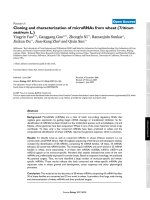
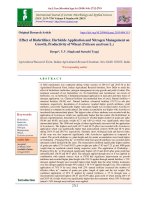


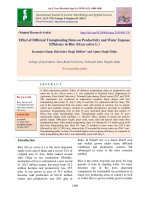
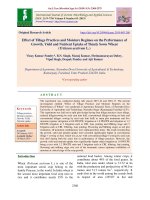
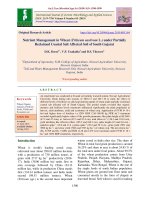
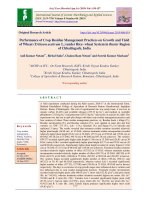
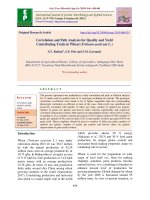
![Genetic diversity analysis of different wheat [Triticum aestivum (L.)] varieties using SSR markers](https://media.store123doc.com/images/document/2020_01/14/medium_uzm1578956512.jpg)